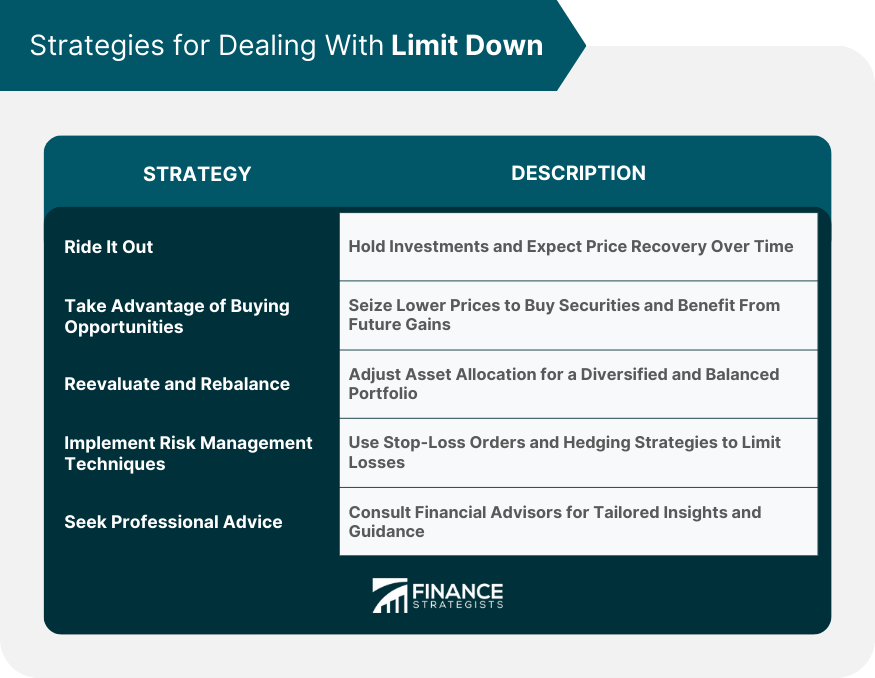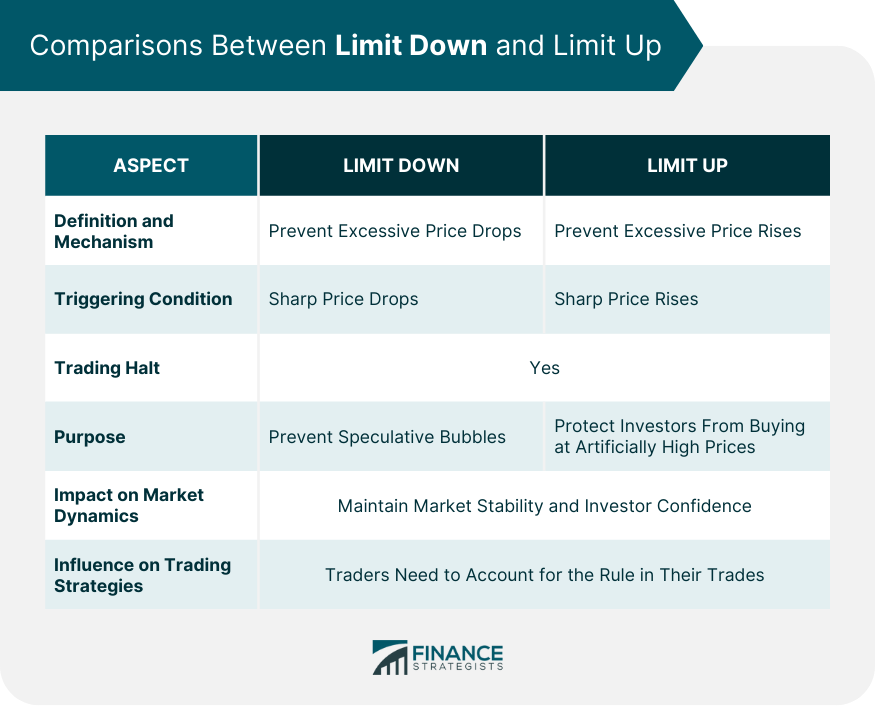Limit down is a term used in financial markets to describe a situation where a futures contract or stock experiences a substantial drop in price. This precipitous decline activates trading restrictions under the rules of the exchange. It's a mechanism put in place by stock exchanges to prevent market panic and protect investors from excessive losses. The main purpose of a limit down is to maintain market stability by preventing extreme volatility. It is an essential aspect of market regulation designed to allow traders time to react to market-moving news or events, thus avoiding rash decisions that could exacerbate the situation. It ensures that extreme price drops don't instigate panic selling, which could result in even steeper market declines. A key component of the limit down mechanism is the reference price. This is typically the price at which a contract or stock closed in the previous trading session, although other prices may be used depending on the specific rules of the exchange. The limit down is calculated as a percentage of this reference price. When the price of a futures contract or stock drops by a certain percentage from the reference price, the limit down rule kicks in. This triggers a halt in trading for a predetermined period, allowing traders and investors to assess the situation and make informed decisions. The specific limit down percentage varies between different exchanges and types of contracts or stocks. However, it is generally set at a level that represents a significant price drop, such as 5%, 7%, or 10%. Once the price drop hits this percentage, trading is halted. The reference price, usually the prior session's closing price, plays a critical role in the limit down mechanism. It provides a benchmark against which the price drop is measured. If the price falls below the limit down level, trading is halted for a set period. Trading restrictions are rules imposed by stock exchanges to maintain order and stability in the financial markets. They can include things like limit up and limit down rules, trading halts, and circuit breakers. Limit down is a type of trading restriction. It is a tool used by exchanges to prevent excessive volatility and protect investors. When a limit down is triggered, trading is temporarily halted, and this halt is a trading restriction. Circuit breakers are another type of trading restriction used to prevent panic selling in the market. They involve halting trading on an exchange for a set period if prices decline by a certain amount from the previous day's closing price. A limit down is one type of circuit breaker designed to prevent a stock or futures contract from falling below a certain level. By halting trading when prices fall by a certain amount, limit down rules can help to reduce market volatility. They give investors a chance to reassess the situation and make informed decisions rather than reacting impulsively to sharp price drops. In this way, limit down rules can help to bring a sense of order and stability to the markets. Market volatility can sometimes be driven by panic selling, where investors sell off their assets rapidly and indiscriminately in response to negative news or events. Limit down rules can help to dampen this kind of unusual volatility by halting trading and giving investors time to think. Traders typically respond to limit down by reassessing their trading strategies and positions. The enforced pause in trading allows them to consider the news or events that may have triggered the sharp price drop and decide how best to respond. Some may see it as a buying opportunity, while others may choose to wait until the market stabilizes. Limit down can have a significant impact on investor psychology. While it can initially cause panic or concern, the pause in trading can also provide reassurance, reminding investors that mechanisms are in place to protect them from extreme volatility. This can help to restore confidence and encourage more rational decision-making. When facing a limit down situation, where the price of a security or market index has reached its maximum allowable decline for a given trading session, investors have several strategies at their disposal. These strategies can help them navigate the situation and make informed decisions based on their risk tolerance and investment objectives. Some investors may choose to stay put and ride out the storm. They believe that the price decline is temporary and that the market will eventually recover. This strategy requires patience and a long-term perspective. Investors who have confidence in the underlying fundamentals of their investments may opt to hold onto their positions and wait for the market to stabilize. For others, a limit down presents a buying opportunity. These investors see the lower prices as a chance to acquire more shares at a discounted price. By buying when prices are low, they aim to capitalize on potential future gains when the market rebounds. This strategy requires careful analysis and research to identify undervalued securities and to ensure that the investment aligns with the investor's long-term strategy. Limit down situations can prompt investors to reevaluate their portfolios and rebalance their holdings. This involves assessing the current asset allocation and making adjustments to maintain a desired balance between different asset classes, such as stocks, bonds, and cash. Investors may choose to reallocate funds from overperforming assets to those that have experienced significant declines, aiming to achieve a more diversified and balanced portfolio. During limit down scenarios, investors may decide to implement risk management techniques to protect their portfolios. This can include setting stop-loss orders, which automatically trigger a sell order if a security reaches a predetermined price. By using stop-loss orders, investors can limit their potential losses in the event of a further market decline. Additionally, investors may consider implementing hedging strategies, such as purchasing put options, to offset potential losses in their existing positions. In times of market volatility and limit down situations, seeking professional advice from financial advisors or investment professionals can be beneficial. These professionals can provide insights, analysis, and guidance tailored to individual investors' needs and goals. They can help investors navigate the complexities of the market and make informed decisions based on their unique circumstances. Just as limit down rules prevent excessive price drops, limit up rules prevent excessive price rises. When a stock or futures contract rises by a certain percentage from the reference price, trading is halted. This can prevent speculative bubbles from forming and protect investors from buying at artificially high prices. Both limit up and limit down rules are designed to prevent extreme price volatility and protect investors. The main difference is in the direction of the price movement they're designed to curb. While limit down rules are triggered by sharp price drops, limit up rules are triggered by sharp price rises. Limit down and limit up rules can both have a significant impact on market dynamics. By preventing extreme price movements, they can help to maintain market stability and investor confidence. They can also influence trading strategies, with investors needing to take these rules into account when planning their trades. Despite its benefits, limit down isn't without its criticisms. Some argue that it can create a false sense of security, encouraging complacency among investors. Others believe it can interfere with market efficiency, preventing prices from accurately reflecting the underlying fundamentals. One major controversy surrounding limit down rules is their potential to exacerbate market declines. When trading resumes after a limit down halt, there can be a rush to sell, leading to further price drops. This can create a negative feedback loop, with each limit down halt leading to further declines. Suggestions for improving the limit down system include refining the thresholds at which trading halts are triggered, improving communication about limit down halts, and ensuring that the rules are applied consistently across different exchanges. Limit down rules can vary significantly across different exchanges. While most use a percentage-based system, some use an absolute dollar value. Additionally, the specific percentage or dollar value at which trading is halted can vary. Some exchanges use an absolute dollar value rather than a percentage, to determine when limit down is triggered. This means that trading is halted if the price drops by a certain dollar amount, regardless of what this represents as a percentage of the reference price. Limit down is a trading restriction mechanism used in financial markets to curb extreme price drops, maintain market stability, and protect investors from excessive losses. By halting trading when prices fall by a certain percentage from the reference price, limit down rules give traders and investors time to reassess the situation and make informed decisions. It helps prevent panic selling and reduces market volatility by curbing sharp price declines. Investors can respond to limit down situations by riding out the decline, taking advantage of buying opportunities, rebalancing their portfolios, implementing risk management techniques, or seeking professional advice. Limit down rules are often compared to limit up rules, which prevent excessive price rises. While limit down rules have their benefits, criticisms include a false sense of security and potential interference with market efficiency. Improvements in the limit down system can be made by refining thresholds, enhancing communication, and ensuring consistent application across exchanges.What Is Limit Down?
How Limit Down Works
Trading Restrictions and Limit Down
Impact of Limit Down on Market Volatility
Limit Down and Market Participants
How Traders Respond to Limit Down
Effect of Limit Down on Investor Psychology
Strategies for Dealing With Limit Down
Ride It Out
Take Advantage of Buying Opportunities
Reevaluate and Rebalance
Implement Risk Management Techniques
Seek Professional Advice

Comparisons Between Limit Down and Limit Up
Definition and Mechanism of Limit Up
Similarities and Differences Between Limit Down and Limit Up
Effects of Limit Down and Limit Up on Market Dynamics

Criticisms and Limitations of Limit Down
Potential Drawbacks of Limit Down
Controversies Surrounding Limit Down
Suggestions for Improving the Limit Down System
Limit Down in Different Exchanges
Final Thoughts
Limit Down FAQs
A limit down refers to a situation where trading for a stock or futures contract is halted because its price has fallen by a certain percentage from the reference price, typically the prior session's closing price.
The limit down percentage is calculated based on the reference price, usually the prior session's closing price. The specific percentage at which trading is halted can vary between different exchanges and types of contracts.
Limit down and limit up are both mechanisms designed to curb extreme price volatility. The difference lies in the direction of the price movement they are designed to control. Limit down rules prevent excessive price drops, while limit up rules prevent excessive price rises.
Limit down helps reduce market volatility by halting trading when a stock or futures contract's price falls by a certain amount. This gives traders and investors time to reassess the situation and make more informed decisions.
Some critics argue that limit down can create a false sense of security among investors and interfere with market efficiency. Others believe that it can exacerbate market declines by encouraging a rush to sell when trading resumes.
True Tamplin is a published author, public speaker, CEO of UpDigital, and founder of Finance Strategists.
True is a Certified Educator in Personal Finance (CEPF®), author of The Handy Financial Ratios Guide, a member of the Society for Advancing Business Editing and Writing, contributes to his financial education site, Finance Strategists, and has spoken to various financial communities such as the CFA Institute, as well as university students like his Alma mater, Biola University, where he received a bachelor of science in business and data analytics.
To learn more about True, visit his personal website or view his author profiles on Amazon, Nasdaq and Forbes.











